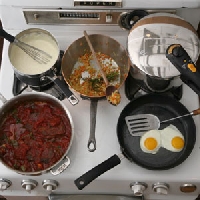
Kitchen size and what you like to cook dictates the pots and pans you need
A full set of pots and pans was once the ideal shower or wedding present, but having the right cooking utensils in your kitchen isn’t the best reason to get married. Besides, only a few of them will ever get used. You can check your mom’s kitchen and look for the worn-out ones or you can read on to find out the basic pots and pans you need to cook most dishes.
A saucepan with a lid is the workhorse of the stove top. A 3 or 4-quart saucepan fits most burners and is used not just for sauces but for cooking rice, blanching or steaming vegetables (with a steamer insert) and preparing anything that’s creamy or liquid.
A smaller 2-quart saucepan is a good partner for smaller cooking tasks or for warming leftovers. You may want to go with a nonstick coating for the smaller saucepan for foods that tend to stick.
The skillet and the saute pan are often confused or thought to be the same, but one of each with a lid belong in the modern kitchen. Saute pans have flat bottoms and the 12-inch size has plenty of room for searing and cooking steaks, chops, chicken breasts and other meats. Use a conventional surface saute pan for putting a nice crispy browned surface on meats and creating bits and juices for sauces.
~
Skillets have rounded bottoms and are better for cooking tasks requiring stirring, like stir-frying, or flipping, like pancakes and omelets. A nonstick skillet is also good for cooking delicate foods such as fish.
The pot that’s made for both the cooktop and the oven is the Dutch oven. With sizes ranging from 5-quart to 8-quart, the Dutch oven handles big and small cooking tasks. In the oven, they’re great for low-heat, slow cooking meals like stews, pot roasts and soups. On the stove top, the tall sides make them great for frying and cooking meats with less splatters.
They can also be used for boiling pasta and cooking larger quantities of foods that won’t fit in a sauce pan. Most cooks prefer the enamel-coated cast iron Dutch oven but standard cast iron works just as well. With its deep rounded sides and wide bottom, a Dutch oven can also work as a wok for stir frying.
For larger families and cooks who like to make soup, a stock pot is essential. A 10 to 16-quart stock pot is excellent for slow-cooking soups or for boiling a big batch of pasta. The stock pot can also handle some of the same stove top tasks as a Dutch oven.
In the nice-to-have category are the wok and the cast iron skillet. Woks are made for stir frying and do it well but can’t really be used for other tasks. Cast iron skillets require special care when seasoning the surface and their weight can be intimidating. It’s the pot to use for making skillet pizzas, cornbread and other stove top or stove-top-to-oven dishes.
These utensils may not be all the pots and pans you’ll need, but they’ll get you started and keep you cooking instead of ordering out.

